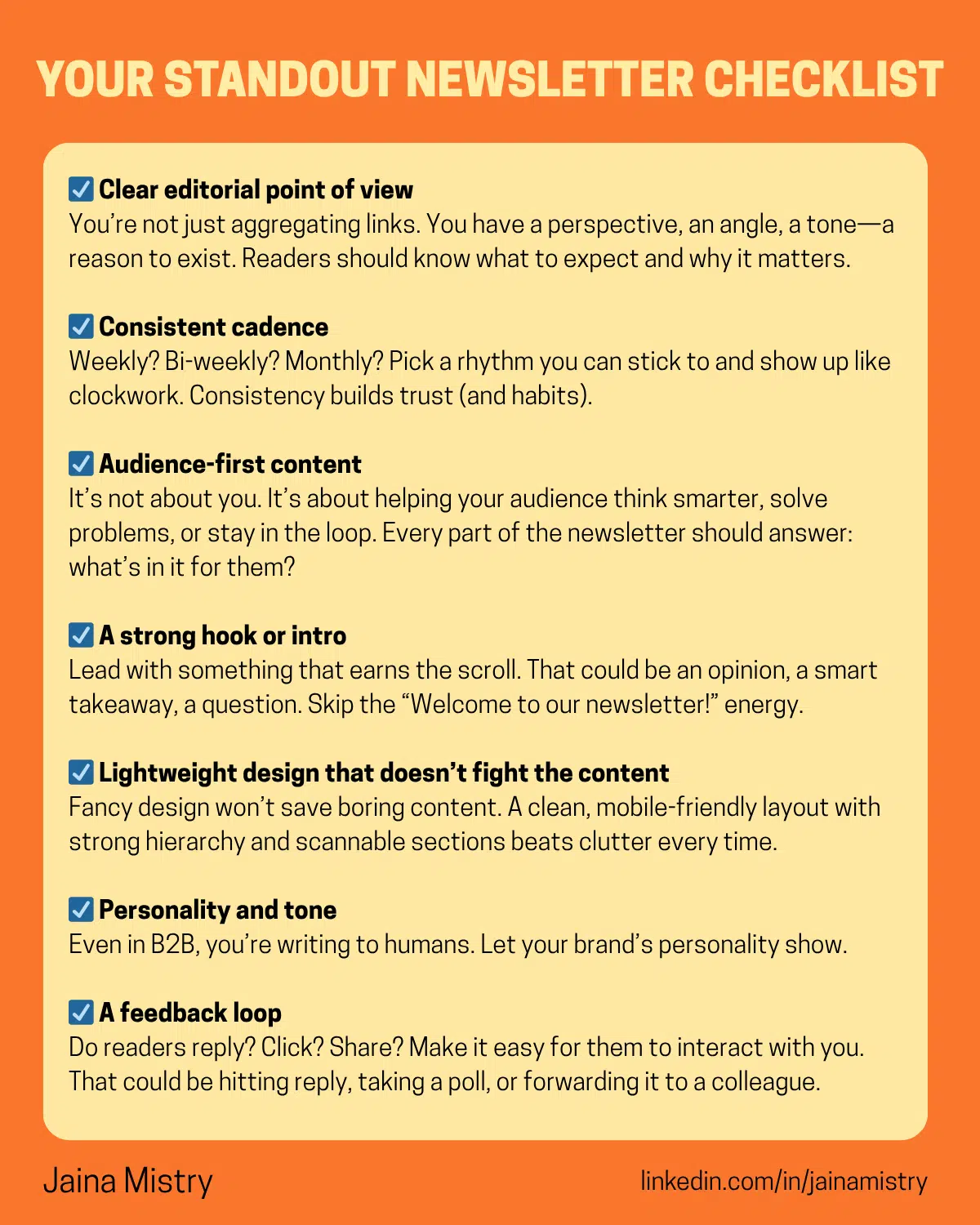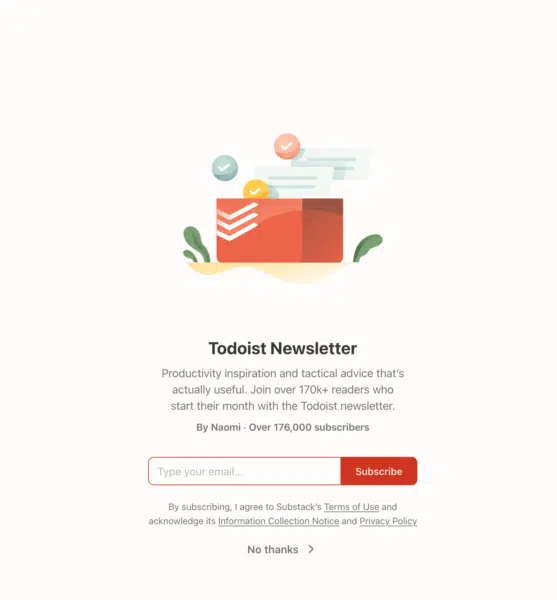The most underrated B2B channel? Your newsletter
Turn your B2B newsletter into a high-impact, audience-first lead nurture engine that builds trust and keeps your brand top of mind.
We’ve all experienced newsletters that are just one promotion after another. Zero personality. No opinions. Nothing to offer. We might even be guilty of sending these.
Those are the ones we unsubscribe from the fastest. A real newsletter delivers consistent value and builds trust.
What is a newsletter, if it’s not just a promotional vehicle?
A newsletter is an email people choose to receive. It exists to keep them informed, entertained or inspired — not to close a deal. And that distinction matters. Newsletters are focused on the audience’s needs vs. the sender’s.
There are a couple of key newsletter formats that show up most in B2B:
- Editorial.
- Curated content.

Editorial newsletter
This type is typically from an individual at the company, written as a letter or long-form piece. It’s opinion-led, values storytelling and offers a unique perspective that connects your audience to your brand.
Editorial newsletters build brand awareness and create personal connections. But they’re not built for clicks. They’re designed to deliver zero-click content — content that’s valuable on its own, without needing to link back to your site.
Here are a few examples of an editorial newsletter:
Curated content newsletter
These are more like roundups. You’re sharing both your own content and helpful third-party content that supports your audience’s needs.
Curated newsletters tend to be a bit more designed, so readers can easily scan and find what’s relevant to them. The user experience of this type of newsletter is critical. And while they’re often built around distribution, that doesn’t mean they should be devoid of perspective.
Even if you’re rounding up other people’s content, you should still lead with your point of view, by sharing:
- Why the content matters.
- How it ties into your audience’s challenges.
- What it signals about your industry or your brand.
A few strong examples of curated content newsletters are Mutiny and Creative Roots by Datalily.
Up to 71% of B2B marketers used email newsletters as a distribution channel in 2024, per the Content Marketing Institute. And 50% of U.S.-based B2B marketers said newsletters had a big impact on content performance.
Yes, newsletters are still worth it. But more importantly, they’re the most audience-focused lead nurture you could have.
Dig deeper: The biggest email newsletter mistake B2B companies keep making
Why should B2B brands consider creating a newsletter?
Because your current nurture program isn’t cutting it.
Let’s be honest: the classic lead nurture journey is… tired. Someone downloads a whitepaper or registers for a webinar, and suddenly they’re flooded with product-heavy emails they didn’t ask for. No one enjoys this and it rarely works.
Compare that to someone signing up for your newsletter. They’re saying:
- I want to hear from you.
- I’m open to your perspective.
- I’m curious about what you know.
That’s intent. And that’s your opportunity.
Newsletters aren’t pushy. They don’t rely on urgency or gimmicks. They show up reliably. They provide consistent value. And they slowly — but powerfully — shape how your audience sees your brand.
In B2B, that matters. Because 95% of your audience isn’t in-market at any given time. That means your biggest job is to stay relevant, visible and trusted — before they’re ready to buy.
Newsletters shift the relationship from transactional to relational. You’re not showing up just to promote something, you’re showing up because you have something worth saying that your audience cares about.
This only works if your content is actually valuable. If you use your newsletter to push a product or set of services, people will tune out. If you use it to share helpful ideas, insights or unique opinions, your audience will stick around.
What makes a good B2B newsletter?
A clear editorial point of view
Your newsletter should have a reason to exist. What’s your angle? What’s your tone? What do you want people to feel when they read it?
Know your audience
What keeps them up at night? What gets them excited? The best newsletters speak directly to those needs and curiosities.
Have a unique perspective
Don’t just echo industry noise. What can you say that others can’t? Or maybe, don’t. Bonus points if you back it up with proprietary data or real customer insights.
You can even use your newsletter to test new messaging or perspectives before rolling them out elsewhere.
Set a consistent cadence
Weekly, bi-weekly, monthly — it doesn’t matter, as long as you can commit to creating quality content on the cadence you’ve selected.
Your audience should know when to expect you. Want to stand out? Consider sending on the weekend. That inbox real estate is quiet and we all know we check our work email on weekends, too.
Define success
No, revenue probably isn’t your KPI. For editorial newsletters, even click-through rate might be irrelevant. So what does success look like?
Here are some metrics that actually matter:
- Subscriber growth rate: Are more people signing up?
- Unsubscribe rate: Are people sticking around?
- Branded search volume: Is your audience seeking you out elsewhere?
Use this framework to define your KPIs:
- Thought leadership? Track forwards, replies and dwell time.
- Lead nurture? Measure clicks, engagement depth and conversions.
- Community-building? Monitor replies, unsubscribes and shares.
Here’s a handy checklist to help you remember what makes a great B2B newsletter:

How to get started with a newsletter — and grow it
You don’t need a flashy template or a massive list to begin. What you do need is:
- A clear reason to show up.
- A format you can stick with.
- A willingness to experiment and iterate.
1. Assemble your newsletter squad
Define who owns what — strategy, writing, design, QA. Even if it’s just you, having a documented process is key. In larger orgs, use a simple RASCI chart (responsible, accountable, supportive, consulted, informed) to make roles crystal clear.
2. Pick your sending platform
Your existing ESP might work. But if you’re building an editorial newsletter focused on reach, platforms like Substack, beehiiv or LinkedIn Newsletters can help you grow an audience beyond your existing list.
For curated newsletters with complex designs, your ESP might be the better route.
3. Set your cadence
Choose based on your team’s capacity. Underestimating how long good content takes is the top reason newsletters die. Start small and grow.
4. Create a compelling signup flow
Make it easy to subscribe. Don’t ask for too much. Remember, this isn’t your traditional lead nurture. Name and email is plenty. Also:
- Don’t force business email addresses. Let people choose where they want your content.
- Show them what to expect. Share a preview edition.
- Use social proof (“Join 10,000+ marketers who already subscribe”) when you can.

Here are some excellent newsletter landing page examples to draw inspiration from:
5. Focus on organic growth
Don’t automatically add your entire CRM to your newsletter list. That’s a great way to spike unsubscribes. Or even the dreaded spam complaint. Instead, invite your existing customers to opt in. A short, friendly “Want in?” message works wonders.
Promote the newsletter on your owned channels — especially social. But don’t just drop a “Subscribe now” link. Share why it’s worth their time. Try a teaser, a quote or a short video walk-through. In today’s environment, hiding or gatekeeping content will get you nowhere.
Dig deeper: 3 marketing tasks genAI can help with — no copywriting involved
Keep your brand top-of-mind with a newsletter
Your traditional nurture sequence might get a few clicks. But a smart, well-crafted newsletter?
That builds recognition, brand affinity and trust. Often long before a prospect is ready to buy. And when the time does come to choose a vendor or renew a contract? You’ll already be top of mind.
A good newsletter makes the shortlist before the RFP even lands in their inbox.
Contributing authors are invited to create content for MarTech and are chosen for their expertise and contribution to the martech community. Our contributors work under the oversight of the editorial staff and contributions are checked for quality and relevance to our readers. MarTech is owned by Semrush. Contributor was not asked to make any direct or indirect mentions of Semrush. The opinions they express are their own.
Related stories
New on MarTech